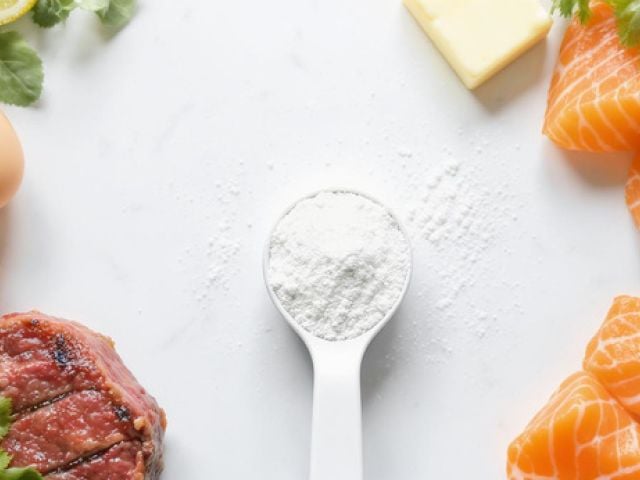
NAD+ vs. NADH: Key Differences and Which is Better
Your cells run on energy. Just like your phone needs a charged battery, your body needs molecular fuel to function properly.
Two molecules power this cellular energy system: NAD+ and NADH. Understanding these energy carriers could unlock better health, more energy, and successful aging.
But which one matters more for your health goals?
Key Takeaways
- NAD+ and NADH are two forms of NAD that power cellular energy production
- NAD+ controls 500+ cellular processes while NADH primarily transports energy to mitochondria
- NAD+ declines dramatically with age while NADH levels remain more stable over time
- Your body easily converts NAD+ to NADH but converting NADH back to NAD+ requires significant energy
- Focus on NAD+ optimization for the biggest health returns since it addresses both energy and longevity pathways
What Are NAD+ and NADH?

NAD+ and NADH are two different forms of NAD, the same essential molecule. Think of them as twins with different jobs in your body.
NAD+ stands for nicotinamide adenine dinucleotide. It’s the “charged” version that accepts electrons from other molecules through oxidation reactions. NADH is the reduced form of NAD that carries those electrons to where they’re needed1.
Your body constantly converts between these two forms as it produces energy.
This conversion happens billions of times per day in every cell. Without it, you couldn’t survive.
The Differences Between NAD+ and NADH
| Feature | NAD+ | NADH |
|---|---|---|
| Charge | Positively charged | Neutral |
| Energy Level | Lower energy | Higher energy (stores electrons) |
| Primary Role | Accepts electrons | Donates electrons |
| Cellular Function | Enzyme cofactor | Energy production |
| Aging Impact | Declines significantly | Remains more stable |
Table showing the key differences between NAD+ and NADH.
The most important difference lies in their functions. NAD+ works like a cellular manager, controlling hundreds of processes. NADH acts more like a delivery truck, carrying energy to your mitochondria.
Your body needs both forms working together. But recent research suggests NAD+ plays the starring role in healthy aging.
How NAD+ and NADH Work in Your Body

Chemical structures of NAD+ and NADH
Your cells use these molecules in a carefully choreographed dance of cellular metabolism. Here’s how cellular energy production works:
Energy Production Process:
- Food breaks down into glucose and fats during glycolysis and other pathways2
- NAD+ captures electrons from this breakdown through cellular respiration3
- NAD+ becomes reduced to NADH (now carrying energy)3
- NADH delivers electrons to the electron transport chain in mitochondria3
- Mitochondria use these electrons to make ATP, your body’s energy currency3
- NADH converts back to NAD+ and the cycle repeats3
This process happens constantly in your muscles, brain, heart, and every other organ. When it slows down, you feel tired and foggy.
NAD+ also serves as fuel for important cellular repair systems. These include sirtuins and PARPs, which fix damaged DNA and proteins.
The NAD+/NADH Ratio
Your cells maintain a delicate balance between NAD+ and NADH, typically around 700:1 in healthy tissues. This ratio serves as a cellular health indicator that reflects your metabolic state. A high ratio signals optimal energy production, while a low ratio suggests metabolic dysfunction and cellular stress.
Why NAD Levels Decline with Age
Your NAD+ levels drop dramatically as you get older4, though the exact rate varies between individuals.
Several factors drive this decline:
Primary Causes:
- Increased DNA damage requiring more NAD+ for repairs5
- Higher inflammation consuming NAD+ faster6
- Reduced production of NAD+ building blocks
- Cellular stress depleting NAD+ reserves7
Your body also starts making more CD388, an enzyme that breaks down NAD+. This creates a double problem: less production and faster destruction.
The decline affects every organ system. Your brain, muscles, heart, and liver all struggle when NAD+ runs low.
Health Consequences of NAD+ Decline

Low NAD+ levels contribute to many age-related problems. Research links NAD+ deficiency to several concerning changes:
Muscle and Physical Function:
- Reduced muscle strength and endurance
- Slower recovery from exercise
- Increased fatigue during daily activities
- Higher risk of sarcopenia (muscle loss)
Brain and Cognitive Health:
- Decreased mental clarity and focus
- Slower processing speed
- Reduced stress resistance
- Higher vulnerability to neurodegenerative diseases
Metabolic Health:
- Impaired insulin sensitivity
- Slower metabolism
- Reduced fat burning
- Poor blood sugar control
Your mitochondria become less efficient at producing energy. This affects every aspect of your health and vitality.
Add 20+ Healthy Years to Your Life
Access the same health optimization strategies used by longevity experts. Weekly insights, exclusive products, member pricing.
NAD+ vs NADH: Which Should You Focus On?
Both molecules are essential, but NAD+ emerges as the clear winner for supplementation and health optimization.
Here’s why NAD+ takes the lead:
NAD+ Advantages:
- Controls over 500 different cellular processes9
- Activates longevity genes (sirtuins)10
- Supports DNA repair systems11
- Declines more dramatically with aging
- Shows better results in clinical studies
NADH Limitations:
- Primarily focused on energy transport
- Less impact on cellular repair systems
- Harder for cells to absorb from supplements
- Limited research on direct supplementation12
Your body can easily convert NAD+ to NADH when needed. But converting NADH back to NAD+ requires significant energy.
This makes NAD+ the smarter target for intervention.
Clinical Evidence: What Research Shows

Multiple studies have tested NAD+ precursors in humans. The results show promise, though benefits vary between individuals.
NAD+ Precursor Studies:
- Nicotinamide riboside (NR) increased NAD+ levels by 48-139%13
- Nicotinamide mononucleotide (NMN) increased NAD+ levels by 60-75% with 250mg daily14
- Some improvements in muscle function15 and sleep quality16
- Mixed results for metabolic benefits in healthy adults
- Better outcomes in people with existing health issues
NADH Supplementation Studies:
- Limited human research available
- Some benefits for chronic fatigue and cognitive function17
- Generally smaller effect sizes than NAD+ precursors
- Less consistent results across studies
The research suggests NAD+ boosting works best when your levels are already low. Healthy individuals see smaller benefits than those with metabolic dysfunction.
Measuring Your NAD+ Status
You can’t optimize what you don’t measure. Testing your NAD+ levels helps determine if supplementation makes sense for you.
Testing Options:
- Intracellular NAD+ blood tests
- Comprehensive aging biomarker panels
- Metabolic function assessments
Testing before and after supplementation shows whether interventions work for your unique biology. This personalized approach leads to better outcomes.
Some people respond dramatically to NAD+ support. Others see minimal changes. Testing helps identify which group you’re in.
Natural Ways to Support NAD+ Levels
Several lifestyle strategies can help support and maintain optimal NAD levels naturally.
Diet and Nutrition:
- Eat foods rich in vitamin B3 (chicken, fish, mushrooms)
- Include NAD+ precursors like trigonelline (found in coffee)
- Consume antioxidant-rich foods to reduce NAD+ consumption
- Practice intermittent fasting to stimulate NAD+ production
Lifestyle Factors:
- Exercise regularly to boost mitochondrial function
- Get quality sleep to support cellular repair
- Manage stress to prevent excessive NAD+ depletion
- Limit alcohol consumption
Environmental Considerations:
- Reduce exposure to toxins that damage DNA
- Maintain healthy body weight
- Stay hydrated for optimal cellular function
These strategies work best when combined rather than used individually.
NAD Supplements
When lifestyle changes aren’t enough, targeted NAD supplements can help restore NAD+ levels.
Popular NAD+ Precursors:
- Nicotinamide riboside
- Nicotinamide mononucleotide
- Trigonelline (newly discovered precursor)
- Combination formulas with supporting nutrients
Key Considerations:
- Start with lower doses to assess tolerance
- Monitor your response through testing
- Choose high-quality, third-party tested products
- Consider professional guidance for optimal results
Individual responses vary significantly. What works for others might not work for you.
Bottom Line on NAD and NADH

Based on current research, NAD+ emerges as the clear choice for most health optimization goals.
NAD+ offers broader benefits beyond simple energy production. It supports cellular repair, activates longevity pathways, and addresses the root causes of aging.
NADH remains important for energy metabolism. But your body efficiently converts NAD+ to NADH when needed.
When to Focus on NAD+:
- General anti-aging and longevity goals
- Improving energy and vitality
- Supporting cognitive function
- Enhancing exercise recovery
- Addressing metabolic dysfunction
When NADH Might Help:
- Acute energy deficits
- Specific neurological conditions
- Chronic fatigue situations
- Short-term energy support
For most people, focusing on NAD+ provides the biggest health returns.
Your Next Steps: Test, Act, Optimize
The best approach to NAD+ optimization follows a proven strategy: test first, then act based on your unique results.
Start with baseline NAD+ testing to understand where you stand. Our Intracellular NAD+ Test provides the most accurate measurement of your cellular NAD+ levels using clinical-grade analysis. This isn’t guesswork – it’s precision health.
Why Testing Matters:
- Reveals your current NAD+ status
- Identifies if supplementation makes sense for you
- Provides personalized dosage recommendations
- Allows tracking of your progress over time
Once you know your levels, targeted action becomes possible. Our Vitality NAD+ Booster uses a clinically validated formula combining NMN and niacinamide with supporting nutrients like creatine and D-ribose for optimal cellular uptake.
For those serious about optimization, our NAD Optimization Starter Package combines everything you need. You get baseline testing, targeted supplementation, and follow-up testing to measure your improvement – the complete Test, Act, Optimize approach.
Your Success Factors:
- Data-driven decisions based on actual testing
- Personalized protocols tailored to your biology
- Professional-grade formulations with proven ingredients
- Ongoing monitoring to ensure continued progress
Remember that NAD+ optimization requires patience and consistency. Results build over weeks and months, not days. But when you follow a systematic approach backed by testing, the improvements in energy, mental clarity, and overall vitality can be remarkable.
Referenced Sources
- https://www.liebertpub.com/doi/10.1089/ars.2023.0375 ↩︎
- https://www.nature.com/scitable/topicpage/nutrient-utilization-in-humans-metabolism-pathways-14234029/ ↩︎
- https://onlinelibrary.wiley.com/doi/10.1186/s40169-016-0104-7 ↩︎
- https://www.sciencedirect.com/science/article/pii/S0006291X24001256 ↩︎
- https://www.nature.com/articles/s41392-020-00354-w ↩︎
- https://pmc.ncbi.nlm.nih.gov/articles/PMC10346866/ ↩︎
- https://pmc.ncbi.nlm.nih.gov/articles/PMC7963035/ ↩︎
- https://www.frontiersin.org/journals/immunology/articles/10.3389/fimmu.2019.01187/full ↩︎
- https://www.sciencedirect.com/science/article/pii/S1550413118301220 ↩︎
- https://pmc.ncbi.nlm.nih.gov/articles/PMC3753670/ ↩︎
- https://www.nature.com/articles/s41598-020-57506-9 ↩︎
- https://pubmed.ncbi.nlm.nih.gov/37971292/ ↩︎
- https://pmc.ncbi.nlm.nih.gov/articles/PMC7352172/ ↩︎
- https://pmc.ncbi.nlm.nih.gov/articles/PMC10692436/ ↩︎
- https://www.sciencedirect.com/science/article/pii/S1568163723002659 ↩︎
- https://pmc.ncbi.nlm.nih.gov/articles/PMC11336149/ ↩︎
- https://pmc.ncbi.nlm.nih.gov/articles/PMC8399248/ ↩︎












